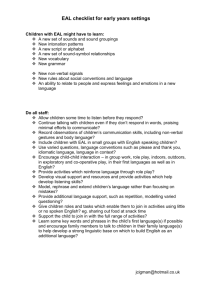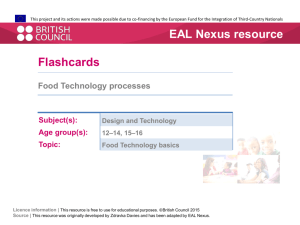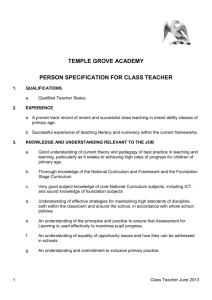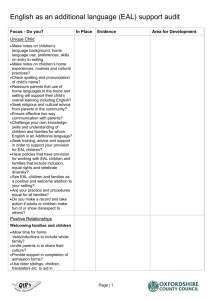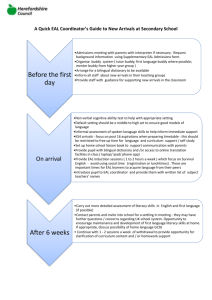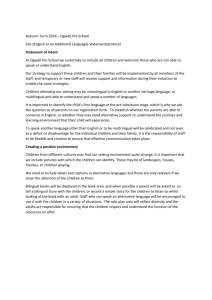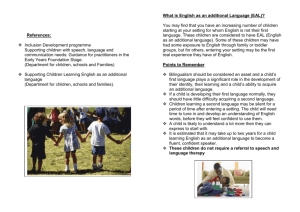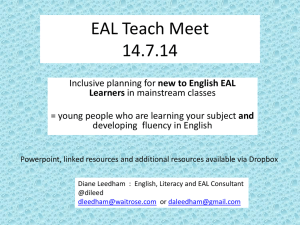Analysing the grammar of writing
advertisement
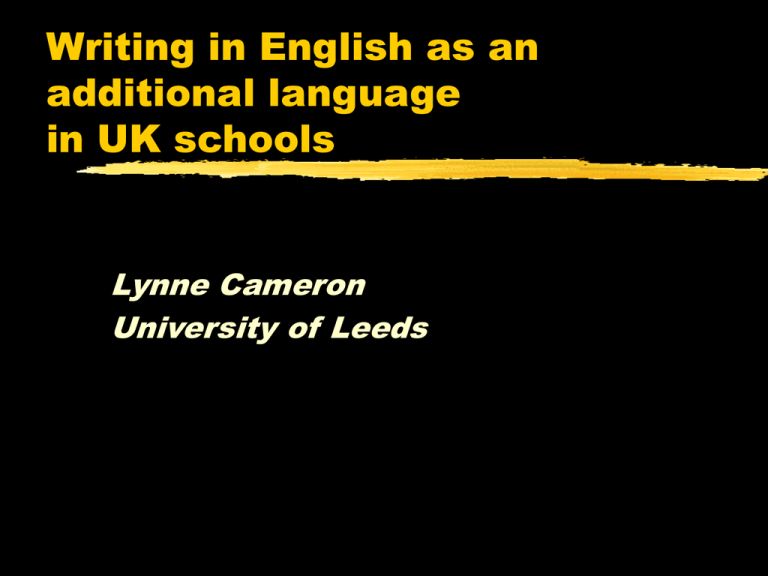
Writing in English as an
additional language
in UK schools
Lynne Cameron
University of Leeds
The research projects
KS4 and post-16: OFSTED funded (2003)
KS2: DfES funded (2004)
“Writing in EAL”
Aims:
to identify in detail features of written
English that bilingual students find difficult,
and thus enable teachers to address them
more systematically in their teaching.
Research procedures
Scripts and writer details provided by
schools.
Close analysis of scripts.
Comparison of results across three
groups:
EAL students achieving at average or below
English mother tongue (EMT) peer group
High achieving EAL students
Key Stage 4
Year 11 students
Mock GSCE exams - English and other
subjects.
Focus group (N=103)
EAL, at least 5 years in UK, C/D borderline or
below in English GCSE
Gujerati, Punjabi, Bengali, Urdu + others
Time in UK education: 10 years 4 months.
Comparison groups
EMT: peers with English as first language
(N = 16)
High EAL: predicted A or B in English
GCSE. (N = 20)
First languages:Bengali, Gujerati + others
Time in UK education: 10 years 10 mths
Key Stage 2
Year 6 pupils.
KS2 English National Curriculum Tests,
Writing. Levels 3, 4, 5.
EAL: (N=138)
at least 5 years in UK
(mean = 7 years 2 months)
First languages: Punjabi, Urdu, Bengali,
Gujerati + others
EMT: (N = 126)
An integrated framework
for writing
The text as a whole
Content
ideas and
topics
composition
purpose
Language
resources
genre
paragraphs
linking
within the text
within the text
Content
the development of
sub-topics, storyline..
Language resources
sentence grammar
words and phrases
punctuation
figurative language
Evaluating the whole text: Genre
Genres as socially conventionalised ways of
writing: a letter to a newspaper (KS4)
a story, a radio advert (KS2)
format
style
voice and purpose
stance
Does the writer consistently and
effectively use the genre required?
Format
Letter openings and closings
Explicit teaching of format seemed to help
EAL students.
KS4 Findings - style
EAL students need support in developing
their awareness of degrees of formality
and the language typical of different
genres (rhetorical adaptability).
High EAL students need more advanced
awareness to judge nuances of style.
EMT students need more familiarity with
written genres and their language.
Style
- EAL errors of language choice
formality
Hope you are fine
I thank you extremely for your patience
talk / writing
I mean just look at
relationship to reader
don’t just sit there - get moving
overly explicit / academic essay genre
I think I have given some good reasons as to why...
KS 4 Findings - voice and
purpose
Writing in specific genres requires
students to adopt and use multiple layers
of voices.
This seemed to lead to confusion about
the writer’s role and purpose, audience,
and how to address the audience.
KS4 Findings - Content and
Linking Ideas
Texts were too short.
Focus EAL group had most problems with
content.
Some had ideas but did not express them
clearly.
Ideas were not developed into detail.
Paragraphing was not used well, by all
writers.
To produce extended
writing on a topic needs...
a range of connected ideas about the
topic
development of each idea
connections made between the ideas as
the writing progresses
linking the sequence of ideas to the topic
and to the purpose of the writing.
Finding ideas to write
about
your experience
your world knowledge
task materials
reading demands
unfamiliar contexts
different genre and register
KS2: pictures
Developing an idea
get more precise
give examples
explain connections
Developing ideas
Riding bikes is a good exercise for life.
It is a way of keeping fit and healthy…
An easly simple quick way of keeping fit is
by just riding the bike for about an
hour each week…
Riding bikes …also makes sure that you
have lower risk of getting a heart
problem.
…helped me loose weight …3 stones ...
Generating ideas to write
about
Think yourself into the writer’s role in the
genre and situation.
Use of drama to clarify voice and purpose.
Practise changing voice and style.
Brainstorm, mind-map around key words.
Break topics down into sub-topics.
Extract key words from task materials and
use for ideas.
Story genre: format
setting
characters
problem
resolution
(moral)
KS2 Storyline: Findings
68% did what they were asked
32% changed the storyline in some way
they fight over a poster, not the game
Problem - boy does not have enough money
to buy the game
EAL level 5 scripts were surprisingly likely to
change the storyline (35%, EMT level 5 - 10%)
Why, and does it matter?
Do EAL students interpret the pictures in
the same way as EMT / as intended?
Do EAL students attach less importance to
sticking close to the storyline?
Do they change because of difficulties
finding the language to describe the given
storyline?
Does it matter in NC tests?
Narrative development
strategies
Description
Direct Speech
Figurative language - metaphors and
similes.
Narrative development:
Findings
Level 3: EAL and EMT similar amounts of
development; Level 4: mixed
Level 5: EMT did more development than
EAL in all components except Setting
Best scripts (level 5 / a lot) did most
development of Character, then Setting.
Least development of Problem.
Narrative development
strategies: Findings
Description most used. Then Direct
Speech, then Figurative Language.
Figurative language used more by EAL
and more by higher levels.
Levels 3 and 5 EAL used more Direct
Speech than EMT.
Level 5 scripts used more variety of
development.
Level 5: EMT used more of each strategy
than EAL, except for Figurative Language
to develop Character.
Story endings: completeness
EAL level 3 had highest number of
incomplete endings
Level 5: EAL much higher number than
EMT
Level 4: EMT higher than EAL, and EMT
level 3.
Story endings: originality
Just over 10% had interesting or original
endings.
Steady increase across levels.
EMT stories consistently more than EAL.
Helping with endings
Listen to and read stories with different
types of endings.
Notice how writers end their stories and
the effect on the reader of a satisfying
ending.
Work out how a story will end before
starting to write.
Write a story with a given ending.
Paragraphing: Findings
Use varied by level, rather than language.
Level 3: 20% of stories showed no use of
paragraphs.
Overall use of paragraphing better than in
Key Stage 4 project.
Evaluating language use
within the text
Sentence level language
What use is made of the possibilities of
English clauses and sentence grammar?
Words and Phrases
What use is made of the possibilities of
phrases within clauses?
Range of vocabulary used.
Accuracy
How accurate is the use of language?
The basic structure of
an English clause
{the government} {should allow}
S
V
{more space} {in trains} {for bikes}
O
A
A
S V O/C A
Subject Verb Object/Complement Adverbial
Joining clauses
Co-ordination
and, but, or
Sub-ordination
when, if, because, who, that
KS 4 Findings - sentence
and clause grammar
High EAL make most use of grammar
resources
High EAL show most variety in clause and
sentence types.
Focus EAL use simple clause and sentence
structure.
Sub-ordinators
Basic sub-ordinators:
that, because, if, so, as, when, who
Advanced sub-ordinators:
which, where, although, after, until, unless etc.
High EAL made twice as much use of
‘advanced sub-ordinators’ as Focus and
EMT.
Sub-ordination at KS4
• High EAL used lowest number of subordinators.
• EMT used most.
• High EAL used most variety of sentence
types.
Subordination at KS2
• Different pattern from KS 4.
• EMT use more subordination than EAL.
• For both groups, the amount of
subordination increases from level 3 to
level 4 to level 5.
• Does the use of variety of clause types
come with maturity?
At KS4, very little use of Subject relative
clauses:
the people (who) I talked to all agreed …
At KS2, EAL use more Subject relative
clauses than EMT.
Not much use of Adverbial clauses:
As you may already know, there are ...
Filling the Adverbial slot:
non-finite clauses
High EAL used more non-finite clauses,
I have written this letter to tell you my reasons
By Burning body fat and raising your metabolic rate,
you can loose weight
but there were very few of the more
advanced types of non-finite clause:
after listing the reasons,… in agreeing to this, …
Filling the Adverbial slot
More Adverbials could be used.
More phrases could be extended into
clauses.
Findings: Length of
Subjects
At KS 4 and KS 2 level 4, EAL writing uses
more single-word Subjects
EMT also use short Subjects
KS 4 high EAL use longer Subjects
At KS 4, high EAL and EMT vary Subject
length with type of writing.
Findings - ‘bare’ noun
phrases
Focus and EMT groups use short and
simple phrases:
the school, the adults, a good idea
KS 4 high EAL use longer phrases with
more interesting words
an easly quick simple way
a larger number of young people
Findings - Words and
phrases
Greatest differences between EAL and
EMT writing was in accuracy at word and
phrase level.
EAL errors
formulaic phrases and collocations
‘small’ words
endings and agreements
consistency of verb tense and modality
Formulaic phrases
are words that are ‘bound’ together
they waited for long (for a long time)
for a lot of time
after some couple of weeks (a)
Strong differences between EAL and EMT;
as at KS4. At least twice as many errors.
from KS2 Script 1
his class girl
lots of people at the front of him
very amazed
I am not going to buy you a game any
more
‘small’ words
prepositions e.g. in, with, up
help on pollution
regret of what they did
delexical verbs e.g. make, put, do
it will do a really good help to us
schools don’t give enough interest
Learning formulaic
phrases
Students should meet / notice / learn
words as parts of phrases, as well as
separately.
Errors in phrases should be corrected, in
speech and writing, sensitively and
consistently.
Explicit teaching of thematic sets of
phrases may be useful e.g. time phrases
articles
omitted
used wrongly
it will decrease (the) traffic
A statistically significant difference
between EAL and EMT at KS4 but not at
KS2
Agreements
Subject -Verb agreements
there are so much traffic
Everyone else are looking
Noun-pronoun agreements
I think bike-friendly measures should be
introduced.. Because it will
Plurals
Next times he is going to
Agreements: findings
At KS 4, EAL made significantly more
errors than EMT writers.
This persisted even for High EAL writers.
At KS 2, there were very few errors and
no significant difference.
EMT made more errors, largely due to
spoken language influence:
in’t they
he hurt his self
Verb endings and tenses
Verb endings
riding bikes doesn’t only helps
the girl knewed
Particular problem for some students at
KS4 and for level 3 at KS 2.
consistency in modality
It would be a great idea
if you all make some kind of meeting …
and should pay £1
if you can’t ride a bike
you can (should) not go to main Roads
because you can (might) have an accident
Verb tenses and narrative
it was the game
everyone was longing for since last month
(had been)
Peter was becoming tired… since, he
queued up at seven in the morning
(had been queuing from)
All the adults queue at the counter
to get ready to pay
(were queuing)
His family were not as wealthy… he did
not buy accessories
Nevertheless, he saved up his money
since he was seven
(had saved)
Comparatives and superlatives
the most easiest, more oftenly, very less
Metaphors and similes
In 70 of 264 stories at KS2.
Mostly similes
glooming eyes like oval pebbles
he ran like a bullet
Mostly one-off; some parallel pairs (script
2).
EAL Level 5 used most (5 per story)
time flew by like pigeons and I was a rock
laying under a tree
Animal metaphors and
similes
the children rushed in like if loads of
elephants saw one little rat
like a group of cheetahs
Errors in figurative
language
Comparison doesn’t quite work:
eyes sparkled like fireworks
looked like dog’s eyes
Inaccurate:
burst into happiness
pouring with tears down their faces
Conclusions
Written language makes different
demands from spoken language.
to organise long stretches of text
to imagine the reader
to use variety of clause and sentence types
visible accuracy
EAL students had learnt what had been
taught
Teaching writing
We need to teach written English.
Different aspects of written English need
different teaching approaches
awareness raising
strategy training
practice
explicit instruction
corrective feedback
Awareness raising
exposure to good writing through reading
directed attention - ‘noticing’
range of genres
how writers end their stories
how they express their ideas
how paragraphs are signposted
how verbs show the timing of events
the use of task materials and pictures
Strategy training
thinking yourself into the role and voice of
the writer
generating ideas through
brainstorming
pictures
key words in task materials
plan the end before starting to write
Practice
Extended writing needs practice in writing
- fast and at length
with gradually reducing support
on realistic (for the students!) tasks
spotting errors
Explicit instruction /
modelling
•
•
•
•
•
•
sets of phrases / collocations
structuring paragraphs
punctuation as part of subordination
the use of Adverbials in clauses
agreements and endings (KS4)
building text development e.g. the
timeline of a story with verbs, time
phrases and clauses
Corrective feedback
Writing makes correct and incorrect forms
visible; is slow enough to notice.
Feedback on errors + modelling of correct
forms:
prepositions and formulaic phrases
articles (KS 4)
agreements (KS4 and KS 2 level 3)
The process of writing?
How do pupils find ideas to write about?
How do they interpret pictures?
How do they organise their ideas?
Do they think themselves into the genre?
How do they compose sentences?
Do they check their writing for errors?
Research reports:
(1) Writing in EAL at Key Stage 4 and post-16.
+ Inspection report “More advanced learners of EAL
in secondary schools and colleges.”
www.ofsted.gov.uk (Publications)
(2) Writing in EAL at Key Stage 2.
www.dfes.gov.uk/research
+ Inspection report “Could they do better? The
writing of advanced bilingual learners at KS2: HMI
survey of good practice.”
